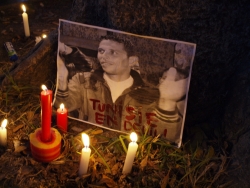 A year ago last Saturday, Tunisian market-seller Mohamed Bou'azizi doused himself in gasoline and set himself alight. He died 18 days later from the burns.
A year ago last Saturday, Tunisian market-seller Mohamed Bou'azizi doused himself in gasoline and set himself alight. He died 18 days later from the burns.
Mohamed's death has been perceived as the starting point of subsequent uprisings, not only in Tunisia but across North Africa and the Middle East. If the symbolic weight of Mohamed's act has yet to be fully realised, the tangible outcome of his sacrificial act was both the coalescence of anger and despair with the Ben Ali regime and the capacity to spark and inspire multitudes within and beyond national boundaries.
Central to Mohamed's death were his material conditions as father and family breadwinner, a situation which left him feeling bereft of any alternative but a profound public wail of rage through self-immolation. In a post-Ben Ali Tunisia, and a Middle East and North Africa fraught with uncertainties, that must not be lost in the search for narratives to explain the so-called Arab Spring. There are some straightforward causes at its core: the fundamental wish of people to live and work and earn --- and simply be --- with the guarantee of certain basic freedoms and opportunities, rather than to suffer under unelected tyrannies and to endure systems of repression. Of course, it serves many in the West to view Mohamed's death as a sortie against dictatorship, rather than a stance against impoverishment and inequality, because accepting the latter requires the West to make certain economic sacrifices (not to mention a recognition of complicity in fostering and sustaining the situation in Tunisia and beyond).
Twelve months later, it is essential that the complex contours around Bouazazi's sacrficie not be collapsed into simplistic narratives to suit those who wish to re-write the story of the Arab Spring. Equally, what must not be forgotten in the attempts to understand and explain Mohammed's death is the grief experienced by those who knew and miss him.
Writing for his personal blog Zunguzungu, Aaron Bady reflects on the meaning of Mohamed's death and its central place in the understanding of the Arab Spring:
Grieving Mohamed Bou'azizi
When a Tunisian fruit-seller named Mohamed Boazizi doused himself with gasoline a year ago and lit a match, and after lingering in the hospital for many agonizing days, finally succumbed to the injuries he sustained, his death was said to have both inaugurated and inspired the “Arab Spring.”
As Rami Khoury has noted, the “Arab Spring” is largely a Western term; within the region it describes, the uprising is more simply and directly called the “revolution” or “uprising” (thawra, intifada in Arabic), or the “awakening” or “renaissance” (sahwa, nahda). Speaking only the Arabic that has made the safari into Kiswahili, I have no way of knowing whether this is true. But it makes sense that we in the West would look at the Middle East and North Africa and understand what is happening through our own familiar political lexicon. So it’s worth being conscientious in recognizing what that lexicon presumes.
The term “Arab Spring,” for example, was first used by conservative American commentators in 2005 to interpret a variety of (ultimately short-lived) democratic developments in the Middle East as vindicating George W. Bush’s “freedom agenda.” This was the neoconservative faith that toppling a dictator Saddam Hussein would open the floodgates to democracy: as Charles Krauthammer not yet come, is still being fought for, is still being oppressed by police, soldiers, torturers, and politicians. And so we miss the historical significance of his death if we credit it with being handmaiden of a history that is still very much in question. As Egyptian novelist Sonollah Ibrahim has insisted of what happened in Tahrir Square:
“It certainly was not a revolution. A revolution has a program and goal—a complete change of reality or the removal of one class by another. What happened was a popular uprising against a standing regime. Its primary demand was “regime change,” though it was not clear what that was supposed to mean, except in the sense of removing the most prominent symbols of the old regime.”
Clearing away the old regime might be the precondition for the emergence of something else, but the latter doesn’t follow from the former as simply as spring from winter, nor does the passage of time do anything more revolutionary, necessarily, than allow the forces of oppression the opportunity to re-brand and re-arm themselves. “Creative destruction” is a capitalist ideology turned neoconservative political praxis, but it’s still a faith, and one that has a remarkably poor track record in fostering democracy.